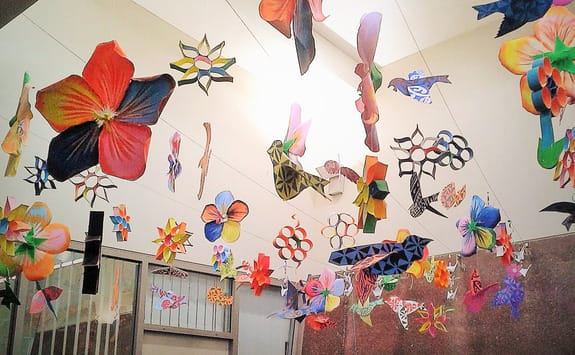09 Jul 2015


Photo: Oranga Community Centre Art Installation
In our busy, noisy world you may have missed it was World Community Arts Day on 17 February.
Community matters. Growing up I remember that the generation of my parents, born around the time of the Depression, were very community oriented, especially the women. People pitched in, helped their neighbours, and spent a lot of time together socially. At least this was true in Alicetown. This was pre-television. For fun people would gather around the piano, sing together and have a good time. Spare cash was scarce as were entertainment options. Social capital was, I would say, pretty high as a result.

In the early 1960s few New Zealanders countenanced the possibility of becoming a professional artist. Yet the arts and participation in them were a part of everyday life and that hasn’t changed even as society has. Arts in the community has many doorways. More people went to church so there was lots of singing, and a lot of our elders knew how to ballroom dance. In fact the ‘dance’ was an integral part of courtship. My mother belonged to a painting group and there were makers and thespians doing their thing in the community with the support of the community.
Different cultures did different things. If you go to the fabulous E Ngaa Uri Whakatupu exhibition of kākahu at the Waikato Museum you will see how the Māori Women’s Welfare League hugely encouraged traditional community arts practices including weaving.
Forms of practice always evolve. For example hip-hop had yet to hit and engage young people in the way it has in the last 25 years. It doesn’t really matter what the form is. We know that for many New Zealanders their creative expression really matters. One of the most powerful bits of information from the New Zealanders and the Arts Survey of 10-14 year olds in 2011 was the finding that 46 percent ‘feel brilliant’ when participating in the arts. It is hard to top feeling brilliant, and of course that feeling can happen whether you are 14, 41 or 82.
I recall the excitement, wonder and fun of participating in the Victoria University Summer Shakespeare productions when I was a student. On at least one occasion we were delighted to be directed by the renowned Colin McColl. The cast and crew drew on a wide pool and as with many similar activities there were a lot of skilled people who were generous with their time in support of our endeavour.
For a number of New Zealanders engagement in community arts is the key focus. Te Matatini is perhaps New Zealand’s biggest single community arts event and one which demands enormous commitment from the roughly 1800 performers in preparation for the finals, this year in Christchurch. For others personal engagement in community arts is the catalyst for a lifelong interest in the arts as an audience member.
So even if you missed Community Arts Day, the great news is that community arts are all around us and there are myriad ways to roll your sleeves up and engage, including online.
We support community arts in a range of ways including the Creative Communities Scheme (CCS), which distributes funding via our local city and district councils country, and through all our other funding programmes. On the link above you will be able to find a list with the CCS administrator for your area.
We have Briar Monro leading our work in this area and she will be happy to hear from you if you wish to get in touch with her. If you have a small project in mind the Creative Communities Scheme is probably your best starting point.
The Palmerston North Creative Communities Scheme is an example of support that is available in your community.
As the great Konstantin Stanislavsky said “Love the art in yourself, not yourself in the art”.
CATEGORIES: Community arts Latest news and blog



